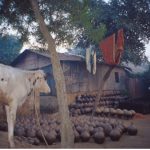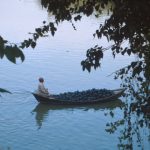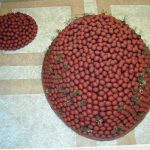- Work in Progress
- Kakran Village
- Work in Progress
- Installation view
1 0 T H A S I A N A R T B I E N N A L E B A N G L A D E S H, Osmani Memorial Hall, Dhaka, Bangladesh, 2002
Curator: Yuri Mitsuda
In cooperation with: The Japan Foundation, Bangladesh Shilpakala Academy, Institute of Fine Arts, University of Dhaka Bangladesh
Kakran Village, earth, iron oxide, flower, water, light
This installation was developed in response to the tragic events of September 11th, which Nagasawa witnessed shortly after moving to New York. The installation consisted of terra-cotta eggs and white flowers symbolizing the nature of life, death and rebirth. Eggs were made from local earth mixed with iron oxide, a red pigment known as bengala (derived from the word Bengal) in Japan.
During her first visit in Bangladesh, Nagasawa worked with art students and faculty of University of Dhaka and created 50 eggs out of clay. She also visited a small island called Kakran in the Shavar district in the suburb of Dhaka to work with the Hindu potters. The production in the village was lead by the father and son team of Tarani Pal and Jagdish Pal. With the collaboration of the entire village, nearly 5000 terra-cotta eggs were created on potter’s wheel and fired in traditional kilns using wood and cow dung as fuel. The eggs were carried in bamboo baskets and put on several rowboats to cross the river. The cargos of eggs were loaded onto three trucks across the bank, and the long journey started on a dusty road, finally arriving at the Osmani Memorial Hall in Dhaka, the site of the Asian Art Biennial at the end of the day.
Several rowboats crossed the river, carrying eggs created from the earth. Earth, carried by the many rivers that flow into the Bay of Bengal—the origin of life. One by one, we passed the eggs, created in different places by people of different religions, through different processes. Our daily conversation and shared labor became a catalyst for our collective vision. The small mound of 500 eggs represents the number of ova a woman releases during her reproductive years, representing an individual life.The large mound represents multiple lives, a global landscape.
On the Edges of Time, when the world is undergoing a transition, when conflicts stemming from social, political, and religious differences are claiming countless lives, together, we created the landscape of life in an ovoid mound, to express our sorrow, to encourage healing between people who embrace different social, religious, and political beliefs, and to evoke the ultimate fragility and resilience of life.




